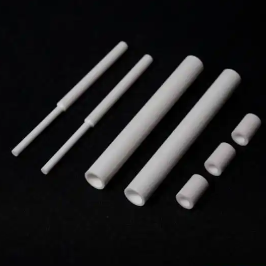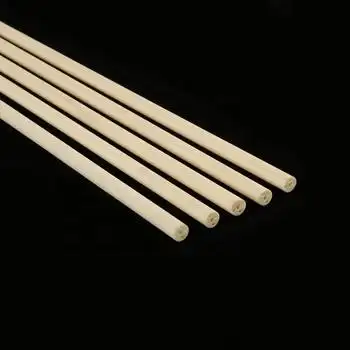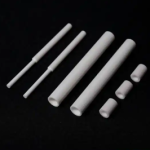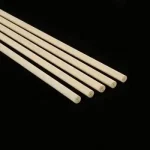Professional Premium Aluminum Oxide Products Supplier
PRODUCT PARAMETERS
Description
Overview of Alumina Rod
An Alumina rod is a cylindrical form of aluminum oxide (Al₂O₃), a highly durable ceramic material known for its excellent electrical insulating properties, high hardness, and high-temperature resistance. Alumina is one of the most widely used ceramics in industrial and technological applications. These rods are produced through sintering or extrusion processes, and their properties depend on the purity and specific manufacturing conditions. They are available in various grades, typically ranging from 99% to 99.9% purity, with a variety of sizes and forms for different applications.

Alumina rods
Features of Alumina Rod
- High Purity: Available in grades ranging from 99% to 99.9% purity, making them suitable for high-performance and high-precision applications.
- High Hardness: Alumina rods exhibit hardness similar to sapphire, with a Mohs hardness of 8–9, making them highly wear-resistant.
- Excellent Electrical Insulation: They are non-conductive and provide excellent dielectric properties, making them ideal for electrical and electronic applications.
- High Thermal Stability: With a melting point of 2050°C, alumina rods maintain structural integrity under extreme temperatures.
- Corrosion Resistance: Alumina is chemically stable and resistant to most acids and alkalis, except for strong bases like molten sodium hydroxide.
- High Thermal Conductivity: While not as conductive as metals, alumina’s thermal conductivity (around 30–40 W/m·K) makes it useful in heat dissipation applications.
- Lightweight and Strong: The material is dense yet lightweight, providing a good balance of strength and low weight.
Specifications of Alumina Rod
| Property | Specification |
| Material Composition | Aluminum Oxide (Al₂O₃) |
| Alumina Content | Typically 92%, 95%, 99%, or 99.5% |
| Density | 3.60 to 3.95 g/cm³ |
| Hardness | 9 on the Mohs scale |
| Tensile Strength | 150-250 MPa |
| Compressive Strength | 2500 MPa or higher |
| Modulus of Elasticity | 300-350 GPa |
| Fracture Toughness | 3–4 MPa·m^1/2 |
| Thermal Conductivity | 20–30 W/m·K |
| Coefficient of Thermal Expansion | 7–8 x 10⁻⁶/°C |
| Maximum Operating Temperature | Up to 1700°C |
| Color | White to off-white |
| Surface Finish | Smooth, polished, or as extruded |
| Porosity | Low porosity (usually less than 0.1%) |
| Water Absorption | <0.01% |
| Electrical Insulation | Excellent electrical insulator at high temperatures |
| Chemical Resistance | Highly resistant to acids, alkalis, and other chemicals |
| Size Range | Typically from 2 mm to 100 mm in diameter (customizable) |
| Length | Customizable, often available in rods of 100 mm to 1000 mm or more |
| Shape | Rods (cylindrical), custom lengths and diameters |
| Packaging | Individual rods, or bulk packages, often in 5 kg to 50 kg quantities |
Applications of Alumina Rod
- Electrical Insulation: Used in electrical components such as insulators, connectors, and substrates due to their excellent insulating properties.
- Semiconductor Industry: Alumina rods are used as insulating materials in high-frequency and high-voltage devices, such as RF components.
- Wear-Resistant Parts: The hardness of alumina makes it suitable for use in wear-resistant components like bearings, bushings, and seals in harsh environments.
- Aerospace and Automotive: Alumina rods are used in aerospace and automotive industries for high-temperature applications, including thermal management components.
- Medical Applications: High-purity alumina is used in medical devices such as prosthetics, implants, and dental components.
- Thermal Management: Used as heat sinks and in applications requiring heat resistance and dissipation.
- Laboratory Equipment: Employed in the construction of laboratory apparatus due to its resistance to chemicals and high temperatures.
- Cutting Tools: Alumina rods are also used for manufacturing cutting tools and abrasive materials due to their hardness.

Company Profile
Alumina Technology Co., Ltd.! We focus on the research and development, production and sales of alumina products, serving the electronics, ceramics, chemical and other industries. Since its establishment in 2005, the company has been committed to providing customers with the best products and services, and has become a leader in the industry through continuous technological innovation and strict quality management.
Our products includes but not limited to Alumina Boat, Alumina Crucible, Alumina Dish, Alumina Foam Filter, Alumina Plate, Alumina Rod, Alumina Bar, Alumina Balls, Filter Alumina, Nano Alumina Powder, Spherical Alumina Powder, ect. please feel free to contact us.(nanotrun@yahoo.com)
Payment Methods
T/T, Western Union, Paypal, Credit Card etc.
Shipment Methods
By air, by sea, by express, as customers request.

FAQs about Alumina Rod
- What is an Alumina rod made of?
- An alumina rod is made of aluminum oxide (Al₂O₃), a ceramic material known for its high purity, hardness, and electrical insulating properties. It is typically produced by sintering or extrusion.
- What are the different grades of Alumina rods?
- Alumina rods are available in various purity grades, such as 99%, 99.5%, 99.8%, and 99.9%. The higher the purity, the better the material’s electrical insulation, thermal conductivity, and overall performance in specialized applications.
- Can Alumina rods be used for high-temperature applications?
- Yes, alumina rods are highly resistant to heat, with a melting point of around 2050°C. They are commonly used in high-temperature environments such as furnaces, thermal equipment, and aerospace components.
- Is Alumina rod electrically conductive?
- No, alumina is a very effective electrical insulator. It has a very high electrical resistivity, which makes it ideal for use in components that require electrical isolation.
- What industries use Alumina rods?
- Alumina rods are used in a variety of industries, including electronics, aerospace, automotive, medical, and industrial manufacturing, especially in applications requiring heat resistance, electrical insulation, and wear resistance.
- What are the mechanical properties of Alumina rods?
- Alumina rods exhibit high compressive strength (2,000 – 3,000 MPa), high flexural strength (200 – 350 MPa), and excellent hardness. They are resistant to abrasion, corrosion, and high-impact stresses.
- Can Alumina rods be machined or shaped?
- Yes, alumina rods can be machined and shaped using specialized tools. However, due to their hardness, machining processes may require diamond tools or abrasives, especially for higher-purity grades.
- What are the limitations of Alumina rods?
- While alumina is an excellent material for many applications, it is brittle and can crack under certain stresses, especially when subjected to thermal shock. It also requires careful handling during machining due to its hardness.
- How do you clean Alumina rods?
- Alumina rods can be cleaned using standard methods such as ultrasonic cleaning, acid cleaning (for light contamination), or wiping with a soft cloth. Strong abrasives should be avoided to prevent surface damage.
- Are Alumina rods environmentally friendly?
- Yes, alumina is non-toxic and inert in most environmental conditions, making it safe for various industrial and medical applications. Furthermore, alumina is produced from bauxite, which is abundant and recyclable.



